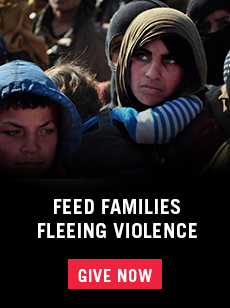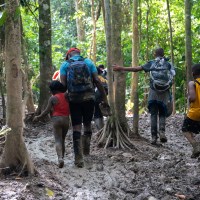Eleven countries. The Andes mountains, the Amazonian Basin, and the Darien Gap. Lifeless bodies fallen in exhaustion, tangled in rain-slicked vines and river weeds. A sixty-mile jungle trek. Wading through waist-high rivers, climbing 1,000-foot mountains while carrying your entire life on your back. Salty, sweaty, triple-digit heat. Sudden, soaking, tropical rain. Only stopping when you’re too hot, too wet, or too hungry. Crossing miles and miles of inhospitable desert. Bandits and smugglers who rape and thieve. This is the journey that Haitians—fathers, mothers, some pregnant, and children—undertake in their search for security. What made them leave?
Dictators
Everyone you know can’t read or write. Everyone is always sick or hungry, and every family has at least one child with skin lesions. Everyone is too scared to speak up because everyone knows somebody who has been disappeared. Everybody has seen for himself a stoned-to-death or burned-to-death body, left hanging in the street as a warning. And everybody knows who’s responsible. This was life for Haitians under the Duvalier government, which lasted from 1957 to 1986. Ninety percent of Haitians were illiterate and suffered from malnutrition, disfiguring skin diseases, or tuberculosis. As a result, from 1972 to 1981, over 100,000 Haitians migrated.
Natural Disasters

You’re driving down a mountain road when all of the sudden, your car is tossed back and forth, like a Matchbox toy. All around you, the buildings are pancaking. You hear screams but they come to you as if from underwater. Thousands of people, zombied in clouds of cement, pour into the streets, some carrying bodies, some bleeding, everybody looking for help. This is the power of an earthquake. For weeks, months, years, you live in a tent. There is no running water. There is no electricity. Food is hard to come by. Sewage piles up. You hear that foreign aid is coming, but you don’t receive any help. Instead, there is cholera brought by Nepalese UN aid workers contaminating the camp’s water supply. You decide to leave. Brazil is granting humanitarian visas, plus it needs workers for the World Cup and the Olympics. You go. You’re not alone. In the aftermath of Haiti’s 2010 earthquake, 98,000 Haitians were granted humanitarian visas or permanent residence in Brazil. From 2010 to 2014, 105,000 Haitians emigrated to the US. By the end of 2016, when Hurricane Matthew struck, over 17,000 Haitians had presented themselves to Mexican authorities, and in 2017, 50,000 Haitians received visas to live and work in Brazil while more than 103,000 Haitian migrants arrived in Chile.

Gang Violence
Imagine wanting to go to school but you can’t. You have money for tuition and you get good grades. The problem is you can’t physically get there. Gangs patrol the only road from where you live to the school in Port-au-Prince, and if you pass by them, nothing will keep you safe. This was one of the reasons Ricardo (not his real name) migrated from Haiti. We met Ricardo in southern Mexico, as he received food and medical care to carry him through on his journey.
Over the last few years, armed gangs have preyed on everyday Haitians, people just like you. They kidnap, rape, and murder the father trying to go to work or the mother taking her kids to school. Very recently, gangs have started targeting women and children specifically. According to UNICEF, the number of women and child victims of gang violence including murder, rape, and kidnapping increased by sixty-two percent from September 2020 to February 2021. Perhaps this is why so many women and children risk their lives crossing the Darien Gap, a deadly stretch of the journey for migrants traveling north from Colombia. Recently, a group of missionaries were kidnapped on their way to the airport and held for millions in ransom. Gang violence is so pervasive, the police have abandoned neighborhoods. As a result, a hospital run by Doctors Without Borders had to close down because the hospital had been caught in a gang crossfire, and there was no one to protect it.
In September 2021, more than 15,000 Haitian migrants, without proper access to clean water and food, camped under The Del Rio International Bridge in Texas, near the border with Mexico, seeking access to the US and with it, a better life. A crippled economy, corrupt leaders, natural disasters, and an impossible level of gang violence have made living in their country, their communities, their homes untenable. Until these issues are addressed, families will continue to move in search of safety.
This is the second in a series of posts that explore why our Haitian friends in Mexico, struggling to find a secure place to call home, are in the situation they are today.


